You have probably heard the famous quote about Wi-Fi clients: “All Wi-Fi clients are equal, but some Wi-Fi clients are more equal than others.” Ok, to be honest, there was no Wi-Fi when George Orwell published Animal Farm. But deep in your heart you know this to be true – even if they are all “just devices”, Wi-Fi clients come in all shapes and sizes. There are mobile and stationary devices, cheap and expensive brands, and also plenty of device types that require high or low data rates. Beyond this classification, another significant point of diversity in wireless devices is the Wi-Fi standard. If you are reading this post, these are probably facts known to you. But actually, our aim is to increase your visibility on the performance of recent Wi-Fi standards, which may directly impact the Wi-Fi experience. For this goal, we compare the performances of existing Wi-Fi standards. If you are perhaps not familiar with the newer Wi-Fi standards, the below figure may help you to understand the evolution of Wi-Fi with respect to the number of users and the types of applications.
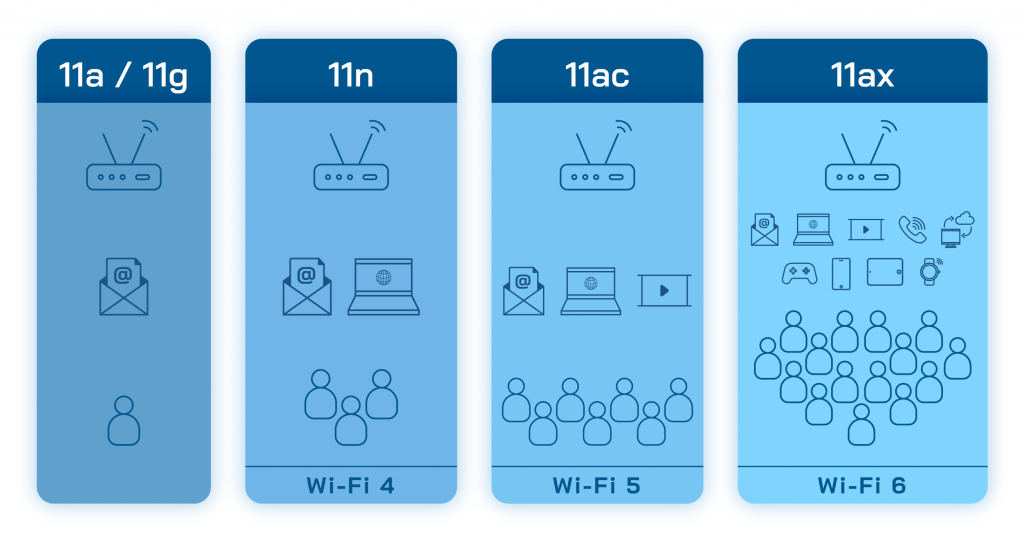
Let’s remember some fundamentals first. As a rule of thumb, Wi-Fi standards are backward compatible with older ones. In addition, a Wi-Fi client can only experience the maximum performance of their device if the connected CPE matches or exceeds the standard of this Wi-Fi client. In other words, if your client supports Wi-Fi 6, but your CPE does not, unfortunately, you cannot observe the highest possible performance. Instead, you are bottlenecked by the CPE’s limitations. Before dealing with these limitations, maybe it is better to answer a fundamental question: How is the distribution of Wi-Fi devices in terms of the standards?
How many devices support Wi-Fi6?
In Europe today, 99% of Wi-Fi client stations are supported by the three most common standards on the market, which are Wi-Fi 4 (802.11n), Wi-Fi 5 (802.11ac), and Wi-Fi 6 (802.11ax) (incl. Wi-Fi 6E). Depending on the country, between 19-36% of current devices support Wi-Fi 6, while the same statistic is between 35-50% for Wi-Fi 5 and 21-38% for Wi-Fi 4, as given in the figure below. Yet, we know that most of the mobile devices on the market are now deployed with Wi-Fi 6 chipsets. For example, the share of Wi-Fi 6 devices has increased by 2% in two months while the amount of Wi-Fi 4 and Wi-Fi 5 has reduced by 1% per each. So basic algebra says that the amount of Wi-Fi 6 devices may exceed 45% in some European countries by the end of 2023. This trajectory may present you with an overview of a range of Wi-Fi standards in the population for the near future. But more significantly, we need to understand the capabilities of Wi-Fi standards. Hence, we evaluate the performances of these standards with anonymized large-scale population data in the next sections.
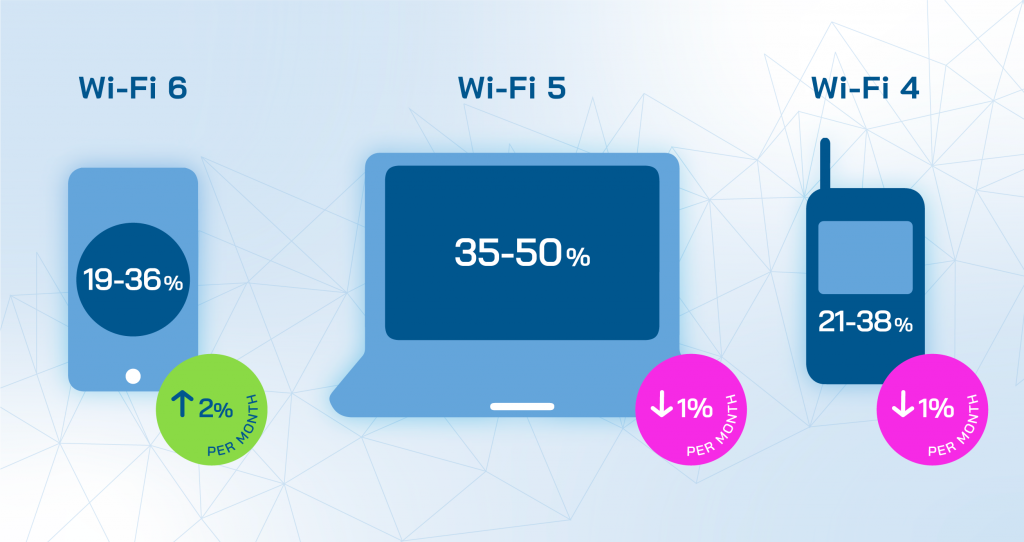
What does Wi-Fi 6 bring?
Ok, the answer is easy to find if you ask this question to any search engine. In this case, you can find basic improvements such as; efficient usage of bandwidth, higher modulation rates, improved channel access with OFDMA and TWT, increased multiuser-MIMO (MU-MIMO) capacity, and more. As a result, maximum achievable data rates are more than doubled. Theoretically, everything looks perfect; however, in the real world, other Wi-Fi-related concepts are involved. As we have discussed, Wi-Fi 6 clients form 19-36% of the population. In other words, there are 2-3 Wi-Fi 6 clients per home on average. However, these devices are data-hungry and most IoT devices do not support this standard, hence the Wi-Fi 6 devices are not the majority of the devices in a network. Because of this reason, some of the features of this standard (e.g., OFDMA and MU-MIMO), which are designed for when the majority of the connected devices support Wi-Fi 6, cannot be effectively utilized just yet.
Advantages of having Wi-Fi 6 clients
To evaluate the Wi-Fi standards in large-scale populations, the first step is to observe clients based on supported Wi-Fi standards. With Lifemote’s advanced analytics based on collected data from all the CPEs, we are able to detect client-wise Wi-Fi problems and correlate these problems with the supported Wi-Fi standards.
As shown below, the population analysis of PHY rate values at 5 GHz is given with a comparison based on a certain value of PHY rates. For example, only 72% of the Wi-Fi 5 PHY rate samples are larger than 300 Mbps at 5 GHz, while this value is 88% for Wi-Fi 6 PHY rate samples. These ratios tend to decrease dramatically for the higher values of the compared PHY rates. Naturally, we can securely say that Wi-Fi 6 clients are faster by connecting Wi-Fi 6-supported CPEs since the PHY rates of Wi-Fi 6 devices are way greater than the PHY rates of Wi-Fi 5-supported devices. Similarly, observations are also valid at 2.4 GHz when comparing Wi-Fi 4 and Wi-Fi 6 PHY rates, but when fast and low latency connections are the concerns, we suggest connecting at 5 GHz.

Table 1: Difference in PHY rates results on population-level analytics with respect to different Wi-Fi standards.
What about Wi-Fi 6 CPEs?
Now let’s look at things from the CPE perspective. As you might note below in Table 2, Wi-Fi 5 and Wi-Fi 6 CPEs get very similar PHY rate distributions. Note that this comparison is done across 4 different models of CPE across different countries. It also means that Wi-Fi 6 CPEs tend to assign higher PHY rates, as expected. However, the key point here is that there aren’t enough Wi-Fi 6 clients today to move the needle from a PHY rate perspective.

Table 2: Population analysis of Wi-Fi 5 and Wi-Fi 6 based on PHY rates at CPEs for each connected client compared to a threshold.
Mesh networks are great options to provide coverage for large homes, and mesh access points (APs) should be compatible with the standard of the gateway to show their capabilities. Similar to the previous observations, mesh APs also provide higher PHY rates, and then naturally increase data rates, as shown in Table 3. Now the difference is very clear – Wi-Fi 6 shines at delivering 800Mbps+ PHY rates, which are what Gigabit fiber and cable users will be expecting.

Table 3: Population analysis of Wi-Fi 5 and Wi-Fi 6 based on PHY rates of mesh AP downlink links compared to a threshold.
For some readers, the presented PHY rate-based discussion may be an expected outcome, but it is clear proof that you need a Wi-Fi 6 CPE if you need a faster Wi-Fi connection. We have also discussed that Wi-Fi 6 is faster on both client and CPE sides. But the standard does not mean everything in Wi-Fi networks – concerns such as Wi-Fi coverage and channel utilization must also be addressed. Let’s discuss coverage problems with respect to Wi-Fi standards.
Do standards also matter for Wi-Fi coverage?
When we deal with Wi-Fi-related problems, the most common issue is coverage. At Lifemote, we classify Wi-Fi coverage as “Poor”, “Mid” and “High”. With the help of the below figure, we can evaluate Wi-Fi standards in terms of coverage performance. As shown below, Wi-Fi 6 clients experienced similar Wi-Fi coverage performance with Wi-Fi 5 at 5 GHz. On the other hand, there are significant improvements against Wi-Fi 4 at 2.4 GHz. In other words, Wi-Fi 6 clients obviously suffer from “Mid” and “Poor” coverage less than other popular standards at 2.4 GHz. Beyond these outcomes, our further analyses of the Wi-Fi coverage performances of the CPEs show that there is no significant difference between Wi-Fi 5 and Wi-Fi 6 coverage performances. Regarding the coverage performances of Wi-Fi devices, we believe that the coverage is more related to the hardware on the device and the band steering algorithms. Hence, a recent device may not guarantee better coverage. In some cases, an older flagship model of mobile devices may perform better coverage compared to the recent economy models. Therefore, similar coverage performances of Wi-Fi 5 and Wi-Fi 6 are not surprising.
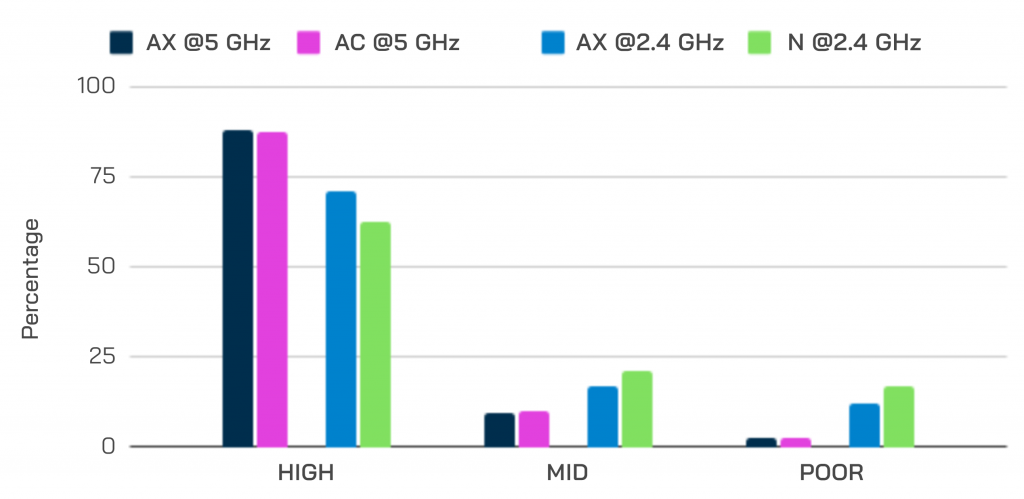
Fig. 1: Wi-Fi Coverage distribution of clients based on Wi-Fi standards at 2.4 GHz and 5 GHz. It should be noted that Wi-Fi 5 is only supported at 5 GHz, hence Wi-Fi 4 is the highest standard behind Wi-Fi 6 at 2.4 GHz.
Contrary to the client-based observations, Wi-Fi 6 CPEs (3 different models) do not guarantee better coverage, as shown below in Fig. 2. It is not surprising since Wi-Fi coverage is mostly related to antenna performance, and there are high and low-end CPEs in the market with various antennas. As a result, it currently seems that some of the Wi-Fi 5 CPEs have better coverage performance, and some of the Wi-Fi 6 CPEs may be more dependent on mesh nodes to provide better coverage. In this case, we suggest extending the coverage of Wi-Fi 6 gateways with Wi-Fi 6 supported mesh nodes, as mentioned above.
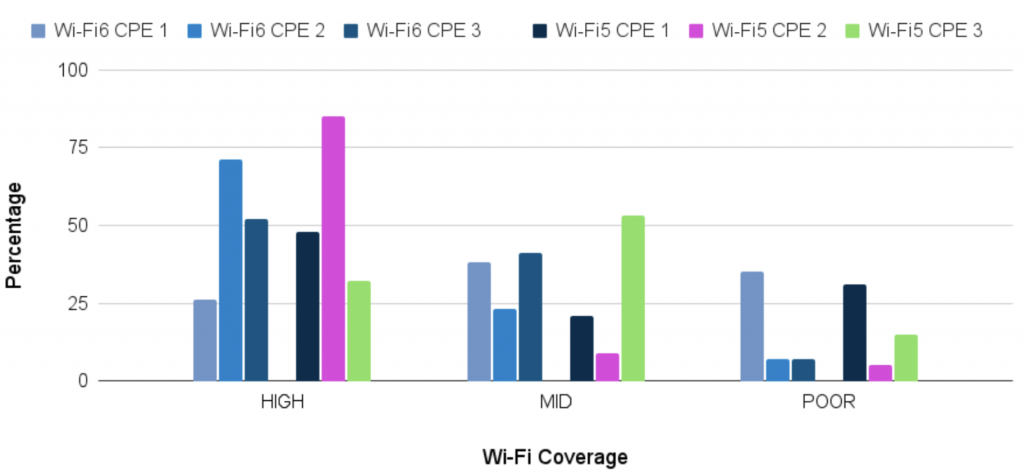
Fig. 2: Wi-Fi coverage distribution of CPEs with respect to Wi-Fi standards.
What else really matters?
Beyond coverage, band usage, time spent under congestion, and active connection times can be considered critical issues to evaluate Wi-Fi standards on the client side. According to 5 GHz population distributions and 5 GHz usage ratios, Wi-Fi 5 and Wi-Fi 6 clients tend to use 5 GHz rather than 2.4 GHz as presented in Table 4. Since the daily average active minutes of Wi-Fi 6 clients are higher than others, we may assume that end users tend to spend more connected time when they have faster connections with recent technologies. One possible reason may be that end users tend to abandon cabled connections if they have proper connection speeds. Another interesting outcome is that Wi-Fi 5 and Wi-Fi 6-supported clients have similar 5 GHz usage. It seems that average band steering performances are similar for tested CPE models (3 different CPE models for each standard) based on 5 GHz usage. However, this won’t be a true observation, since the band steering performances are highly dependent on the hardware (antenna) and software (band steering algorithms).
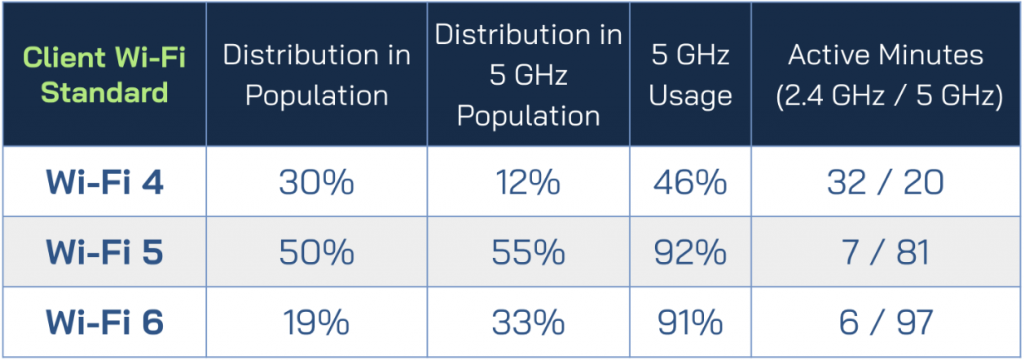
Table 4: Results on population-level analytics with respect to different Wi-Fi standards of clients, which are connected to Wi-Fi 6 CPE.
Now it is time to move to the CPE side and see the impacts on Wi-Fi standards at the last edge of the ISP’s under-control territory. Firstly, we believe that user behavior is similar for both standards with respect to the amount of weekly downloaded and uploaded data in the below table. When we focus on congestion, Wi-Fi 5 and Wi-Fi 6-supported CPEs distinctly behave at 2.4 GHz. As shown in Table 5, the time spent under congestion ratios of Wi-Fi 5 CPEs is higher at 2.4 GHz, whereas there is no clear gap at 5 GHz. Even if more stations are connected to Wi-Fi 6 CPEs on average, it is significant to see there is less congestion with similar active minutes and data usage. We believe that one possible reason for less congested networks is the improved band steering algorithms on the recent CPEs.

Table 5: Results on population-level analytics with respect to different Wi-Fi standards of CPEs.
What do we suggest?
At this point, you might’ve gotten lost among the statistics. Here is what we really want to take away from all this:
- Wi-Fi 6 clients are common and their numbers are increasing rapidly. However, current Wi-Fi 6 clients desire high data usage, and some other device types such as IoT still do not use Wi-Fi 6.
- As expected, Wi-Fi 6 clients and CPEs are faster in terms of PHY rates. When a Wi-Fi 6 gateway is deployed, Wi-Fi 6 repeaters should be deployed to distribute Gigabit-level data – the gains of Wi-Fi 6 are only really enjoyed across a mesh in most homes.
- There is no guarantee of significant improvements in congestion levels at 5 GHz between Wi-Fi 5 and Wi-Fi 6. However, to reduce 2.4 GHz congestion CPEs with band steering performance (Wi-Fi 5 or Wi-Fi 6) can help. In case of an upgrade, it should also be noted that Wi-Fi 6 (or beyond) CPEs should be preferred instead of Wi-Fi 5 for the long term.
- If you have chronic coverage problems, an upgrade to Wi-Fi 6 likely won’t solve your challenges. Mesh deployment where that doesn’t cut it, is the best way to tackle coverage problems.
What about beyond Wi-Fi 6?
So far, we have compared Wi-Fi 6 with older standards, but what about its successors? It is obvious that you have to upgrade your CPEs one day to survive in the market, but you could maybe also skip simple Wi-Fi 6 technology and invest in further options. Unfortunately, we don’t have a lot of numbers for Wi-Fi 6E or Wi-Fi 7, since they are not deployed at any scale yet. But in the case of upgrading directly to Wi-Fi 6E or Wi-Fi 7, it will be a costly investment. Of course, these are valid choices in case your priority is being a pioneer in the market. For those with more pragmatic budgets, the numbers indicate that well-distributed Wi-Fi 6 mesh appears to be the way to go.
About the Author:
 Özgün Demir
Özgün Demir
Research Engineer
ozgun.demir@lifemote.com



